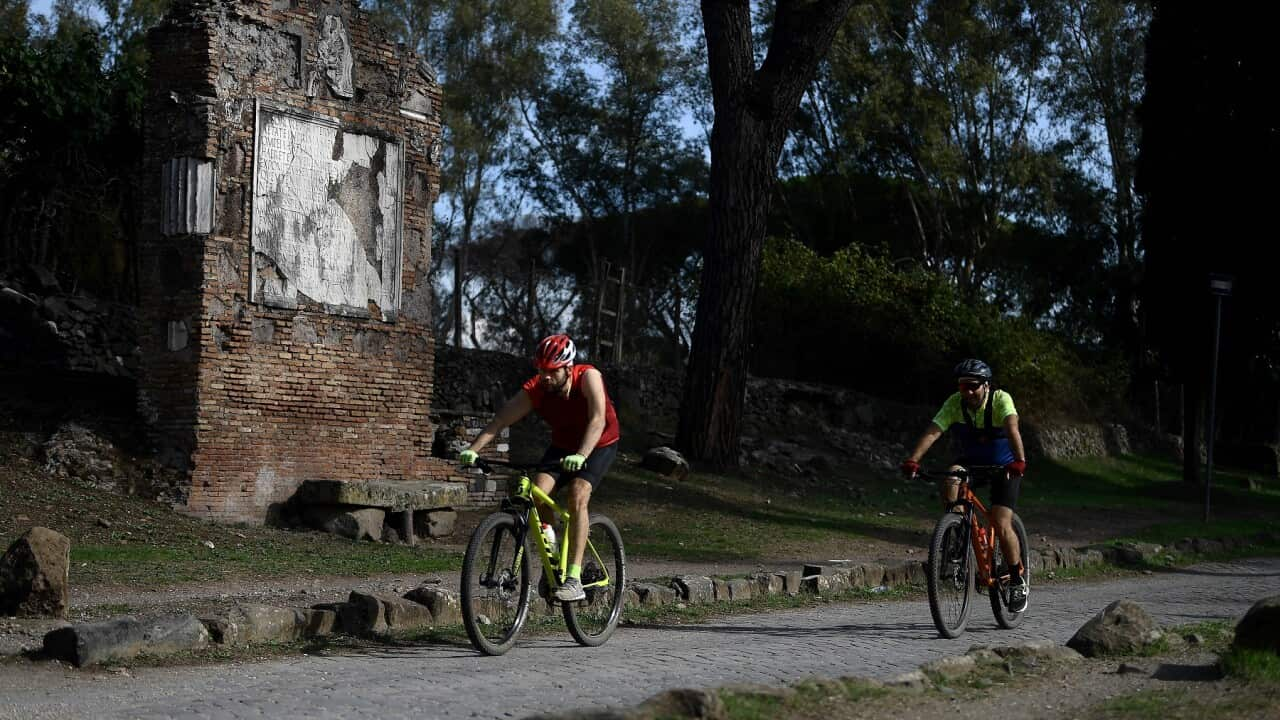TRANSCRIPT
It's ancient Rome's first highway, today parts of it remain intact - explored by tourists on foot and by bike.
Built 2,300 years ago, the Appian Way connected Rome to Brindisi in southeast Italy.
Running more than 500 kilometres in length, it was used to transport military supplies as well facilitating economic trade with Greece, Egypt, and North Africa.
The Romans called the road Regina Viarum or the Queen of Roads.
It was part of a network of roads that connected Rome to some of its most distant settlements.
At the time when it was built, in 312 BC, it was the widest and longest road in existence - made of large, flat stones that have stood the test of time.
It fell into disuse, with parts of the route buried under farms, highways, and modern construction.
It then came to public attention in 2015, when a writer for the La Repubblica newspaper, Paolo Rumiz, decided to walk the route - enlisting the help of hiker, Riccardo Carnovalini to map the path.
That same year, Italy's government announced a plan to restore the route and encourage tourism.
Simone Quilici is the director of the Ancient Appia Archaeological Park.
"Today, the ancient Appian Way is not only a big open-air museum started in the 1800s, but it's also an immense green area, a place where Romans come for leisure time: biking, hiking and visiting monuments, of course. And so, it's one of the biggest suburban parks in Europe. So, it's both a monument and a big public park."
Now, an advisory body of the United Nations' cultural agency, UNESCO, has recommended the Appian Way be considered for inclusion on its World Heritage List.
Mr Quilici says it is a worthy contender.
"The ancient Appian Way was the queen of the roads. It was a big engineering work, so it deserves, I would say, to be in the World Heritage list. It would be the first ancient Roman road to be in the list. So, I would say we have everything okay for this nomination. Of course, it's a big challenge. We need to, in some way, demonstrate that we’ll be able to protect this and also to enhance this big monument, longer than 500km from Rome to Brindisi. So it will be also one of the biggest, UNESCO sites here in Italy, for sure."
Professor Giorgio Piras at the University of Rome La Sapienza studies ancient Rome.
He says the Appian Way is a marvel of civil engineering - and also an example of Roman ingenuity.
"It (the Ancient Appian Way) played a key role in the history of Rome, in the Italian peninsula and the conquering of the Italian peninsula. So, it's without doubt the most important ancient street built by the Romans."
He says inclusion of the site on the UNESCO World Heritage List in some ways would be a first.
"You know that Italy obviously has already a very huge number of sites recognised by UNESCO, but that would be the first case of a road of an ancient street to be recognised as heritage of the entire world. And that would mean, in some way, to recognise the Italian landscape as heritage of the entire world."
Mr Quilici says walking the route is immensely satisfying - and also educational.
"Along the Appian Way there were, mainly tombs by important families. And so the most important would be the mausoleum of Cecilia Metella. But we also have big archaeological sites, such as Villa dei Quintili - it’s more than 30 hectares of landscaped, well protected, where you have the remains of a huge imperial villa owned first by the Quintili brothers and then by Emperor Commodus."
Giving her verdict is Australian tourist Caroline.
"I mean, every part of it is interesting. You either see the old stones or you see buildings that have been or structures that have fallen down and wondered what they were and try and imagine how people used the road in the past. So all of that is very, you know, is fascinating, I think. I like the goats. I think that's also, you feel like you're in the film The Dolce Vita with the goats. So, I think not any particular favourite spot, but just the experience of being able to be along the road and to enjoy that and to imagine what it was like, you know, over the years is interesting everywhere along it."
She says walking the Appian Way was an item on her bucket list.
"So my parents actually first came to Rome in the late 1960s from Australia and were among the few people that they knew who had travelled to Europe from Australia. And they talked about this road. And my father has photographs of it from the 1960s. And, so it was very interesting for me to come back and see it, the same thing that they saw, but I guess from a different perspective because it's, you know, 50 years later. So, I think it's very important that these things are preserved. And I think for me, it's fascinating to know that the road that we were riding our bikes on was built, you know, 2000 years ago and is still there. I wouldn't have fancied riding in a carriage or a chariot all the way to Brindisi, probably. It's pretty bumpy, but, I think if you don't preserve these things, then people forget that they're there and other things take over them. So, I think, and it's just so incredible that there are so many parts of the old buildings that are still standing and preserved."
If approved by UNESCO, the Appian Way will become the second longest site to make the World Heritage list after the Great Wall of China.














